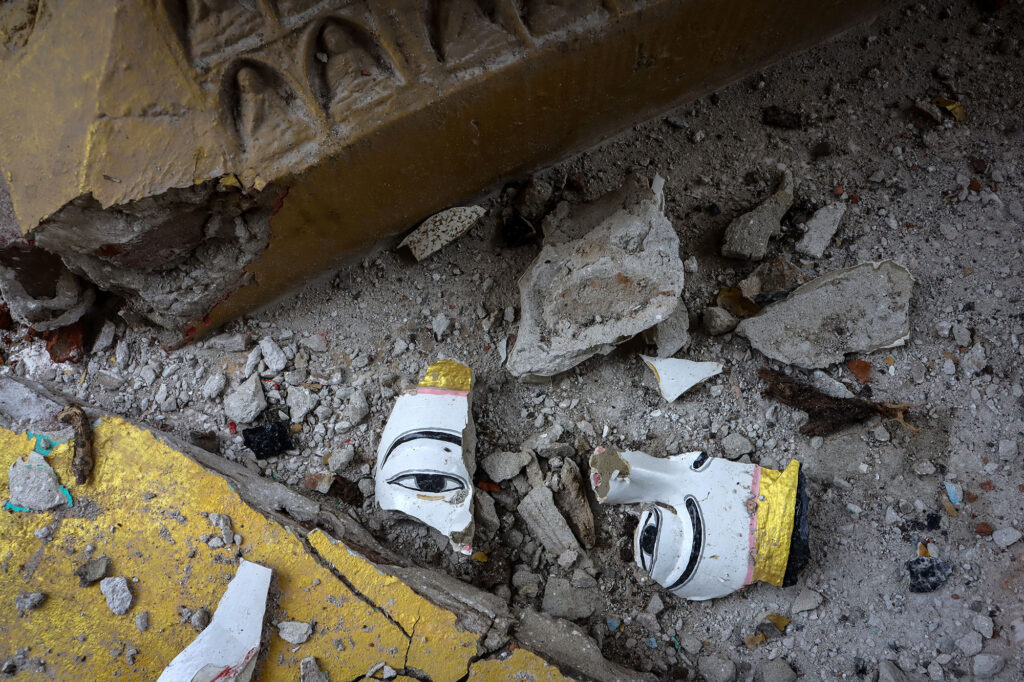In the hours and days that followed the major 7.7 magnitude earthquake on March 28, the photographers stepped into the dust, the silence and the chaos. Some were there as buildings fell. Others arrived to witness what was left behind. What they saw cannot be forgotten. What they heard still echoes.
“At first, I was torn between two instincts – whether to help people or document the moment through my camera. In that moment, I decided that capturing the raw emotions of the people around me would serve a purpose. The expressions – fear, hope, confusion, and strength – told the real story,” said Zide, the photographer with his real name withheld for security reasons.
“I used to take photos of beautiful landscapes. Now, I’m capturing collapsed homes, pagodas, and historic buildings destroyed by the earthquake. It deeply saddens and shakes me emotionally. I never imagined I would end up photographing this kind of destruction. I watched buildings crumble right in front of me, people running for their lives, some jumping from upper floors in desperation, others buried beneath the rubble, and some who never made it out,” said another photograher, Ko C, also with his real name withheld for the same reasons.
“When I arrived, days had already passed since the earthquake, but the damage – both visible and invisible – lingered. The city was physically broken, and the people seemed emotionally numb. Looking at their faces, I couldn’t sense much feeling – neither sorrow nor relief. I keep wishing to see emotion in people again – any kind of emotion. Sadness, joy, even anger. Because perhaps what’s most haunting isn’t the destruction itself, but the emptiness it leaves behind. The absence of feeling,” said GoDark, another photographer of the exhibition, 7.7 MMERQK: Capturing Myanmar People’s Unheeded Cry.
Even weeks after the earthquake, many now still sleeping outdoors, too afraid to return to cracked buildings once they called homes, continue to be shaken up by aftershocks.
Meanwhile, the junta has not responded with relief, but with violence, the photographers echo the news reported by several trusted news agencies, including the Irrawaddy in Myanmar. Where the junta fails, the people respond with what they have – not only with food, shelter, and care, but with presence, courage, and dignity. This truly shows the unity and spirit of Myanmar – even in the hardest times, they continue to lift each other. In the face of loss, they become each other’s strength.
“The whole day I heard whatever I go…
‘Mother… What is wrong?’
A boy was crying over the phone,
A woman telling to her mother, ‘grand daughter was gone.’
Others just sat silently beside the bodies, covering them with cloths and staring into the distance.
It was hell. Truly.
As soon as I arrived at the hospital, it felt like the world was collapsing. It was a scene straight out of a movie – something I’s only ever seen on screen,” said Linkar, another fellow phtographer of the exhibition.
The stories behind the lens and cameras are being told through the eyes and delicate senses of this group of photographers from Myanmar. Curated and organised by a group named Platform 36, in collaboration with SEA Junction and Bangkok Tribune News, and in partnership with CMB, their exhibition is set to run until the middle of this month.
The exhibition showcases photos of the disaster’s impact, presenting powerful visual documentation of earthquake-affected areas near Mandalay and Sagaing, where significant damage has been reported. The display will also highlight surrounding regions such as Nay Pyi Taw, Bago, Magway, and parts of Shan State. Whenever available, “before” images of these post-earthquake scenes will be included alongside photo captions.
Besides aiming to increase public awareness, the objective is to raise funds for earthquake-affected communities.
Platform 36, Bangkok Tribune, and SEA Junction are all working pro-bono, and SEA Junction is shouldering the costs of the exhibition fully as part of the CMB-supported program “Staying Resilient Amidst Multiple Crises in Southeast Asia” in the sincere hope that many will donate. All funds will be entirely used toward medical supplies and healthcare services via trusted local and civil society organisations working on the ground.
The exhibition, which was first introduced on the Corner Space, 1st floor, BACC on May 6, will be on display until May 18. More details @Photo Exhibition: 7.7 MMERQK, Capturing Myanmar People’s Unheeded Cry

Photo: ©Ko C

Photo: ©Linkar

Photo: ©Zide

Photo: ©Zide

Photo: ©Linkar

Photo: ©Zide

Photo: ©Linkar

Photo: ©GoDark

Photo: ©Zide

Photo: ©Linkar

Photo: ©GoDark
An independent collective and platform dedicated to supporting the next generation of photographers and photojournalists, especially those from overlooked or marginalised communities. Named after the traditional 36 exposures on a roll of film, Platform 36 symbolises creative potential, storytelling power, and the belief that every frame matters.

